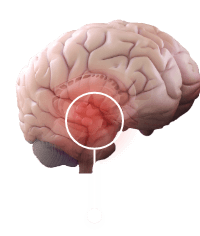Our understanding of VMS is heating up
OUR UNDERSTANDING OF VMS IS HEATING UP
It’s not only about estrogen
Vasomotor Symptoms (VMS), also known as
hot flashes and night sweats, aren’t caused
by declining estrogen alone—we now know
that VMS result from unopposed neurokinin
B (NKB) signaling and altered activity of the
kisspeptin/neurokinin B/dynorphin (KNDy)
neurons in the temperature control center
of the hypothalamus.1-3


Inside the source of a hot flash
NKB and estrogen modulate KNDy neurons in a delicate balance, contributing to body temperature regulation. KNDy neurons are stimulated by NKB and inhibited by estrogen.2,4,5
Inside the source of a hot flash
Through the menopausal transition, estrogen declines, disrupting the balance with NKB.2,5,6
Inside the source of a hot flash
Unopposed, NKB signaling causes heightened KNDy neuronal activity, which leads to hypertrophy of KNDy neurons and altered activity on the thermoregulatory center.2,5,6
Inside the source of a hot flash
As a result, the thermoregulatory center triggers heat dissipation effectors that cascade into hot flashes and night sweats—VMS.2,6
Part 1
Part 2
Part 3
Part 4
Watch how it works
SEE ALSO

VMS IN HER WORDS
“It throws everything off kilter. [There
are] no rules on when or why they [hot
flashes] happen; they just happen.”
VMS IN HER WORDS
“It throws everything off kilter. [There
are] no rules on when or why they [hot
flashes] happen; they just happen.”
Download the mechanism of VMS flashcard
Download PDF